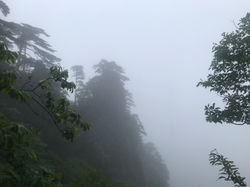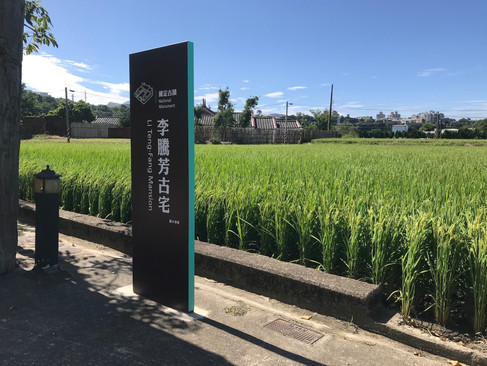North Taiwan's River Heritage - Daxi
- Chi Hsu

- 2021年10月18日
- 讀畢需時 4 分鐘
已更新:4月19日
吉客鏈:19 世紀北台灣發展 X 水運時代 X 大溪先民開墾文史
You may know of the Thames River's historical importance for London, the Hudson River and New York, the Mississippi River and New Orleans, but you probably do not know the river that helped early Taipei's commercial activities.

Even as a Taipei resident, it took me a while to figure it out because the riverfront scenery isn't easy to see from streets. The modern urban regeneration has built the breakwater wall to protect the foundation of city infrastructure and buildings. Four years ago (2018), I took my family to attend a Bangka's walking tour to know Taipei's past better. The guide pointed to a distant wall at the end of the street and said there were many boats (behind the wall) on the river for trading........ we were all astonished.
The Rivers - Tamsui River and Dahan River
During the pandemic period, I have taken more historical walking tours, so I picked up on early Taipei's prosperity - along the Tamsui River and its upstream area and made the mapping below to illustrate it more clearly.
There were four major trading ports in the 18-19th century conducting international business of North Taiwan (Formosa): Tamsui, Dadaocheng, Bangka (Monga) and Daxi. To see the vast mountains surrounding the Taipei metropolitan, you may already guess that the trading goods would be related to the mountains' beneficial resources.

(Mapping by Chi Hsu) The number marked which indicates the relevant image below:
Image 1: Tamsui River into Taiwan Strait.

(Photo credit | Chi Hsu)
Image 2-3: The Tamsui River view from the bridge, nearby Dadaocheng and Banchaio. Only outbound commuting is able to take a peek of the water view across the bridge.
(Photo credit | Chi Hsu)
Image 4-5: Upstream of Tamsui River - the Dahan River in Daxi, Taoyuan - the most important in-land port for inbound shipping daily goods and outbound shipping tea, rice, camphor, coal mining in 18 -19 century. The peak period was during 1892 - 1897 with 3~4 hundreds of merchant companies ran by British, Spanish, overseas Chinese as well as local businessmen.
(Photo credit | Chi Hsu)
Daxi - Upstream Town
Last Friday (15th Oct. 2021), it was my first time to visit Daxi and I fell in love with its historical district with shops and food very much. The old streetscape has been preserved in the facade of street houses since 1919. How beautiful is the skyline which remained!

(Photo credit | Chi Hsu)
However, it was to discover the profound history of the glorious trading time that was my intention this trip. I was Imaging how the bustling merchant town in the past has transformed to a slow walking tourist town. To know about the early settlements, seemed more interesting than the street vendors and gift shops for me (Well, actually, I'll just wait for some leisure shopping until next trip with family together).

(Photo credit | Chi Hsu @ Daxi Wood Art Ecomuseum)
The Daxi history profile and its exhibition brochure both indicated that the Lin and Lee Families were the most influential settlers. It was delightful to join a Daxi walking tour, organised by Art Focus and guided by Charles Lin, to explore more insights of the early settlements.
Lin Family's Castle : I mentioned the Banchaio Lin Family in the travelogue of TWO Lin Mansion's Gardens: their ancestors came to Taiwan in 1782 then built their Mansion in 1851 when they were the wealthiest family in Taiwan. Prior to the year of 1851, the Lin Family settled in Xinchuang and Daxi. At the early 19th century's Daxi, they built a Castle in 1818 but demolished by Japanese attack in 1895. When the tour walked to the heritage of the Castle where only stood the 'well-maintained' gate! The castle's model at the exhibition, helped to picture its original outlook.
(Photo Credit | Chi Hsu)
Lee Teng-Fang Mansion : Lee Family built its mansion in 1860 when 'Teng-Fang' passed the Qing Chinese Imperial civil service exam. Lee's ancestors settled here and ran the trading business well as Daxi was the transportation hub of tea, rice, camphor and coal mining from the mountain ranges. The Mansion represented the family's fortune and prosperous status.
Click left to download the mansion's architecture profile and layout. And, share with the video below to see its vibe.
(Photo Credit | Chi Hsu) The Mansion is surrounded by the rice field. Very harvested landscape.
The Lee family also had their own merchant company, Jing-Xin, in town and we also passed its heritage site which retained only the facade.
(Photo Credit | Chi Hsu)
Daxi Bridge
Just as with the London Bridge lying on Thames River in London, there is a Daxi Bridge lying on Dahan River in Daxi. Both bridges were first built simply then had re-built again and again due to over-use and damaged.
At the end of the tour, we walked through the Daxi bridge where is the best spot to imagine the hundreds of boat in/off the shore to/from the pier.

(Photo Credit | Chi Hsu)



































留言